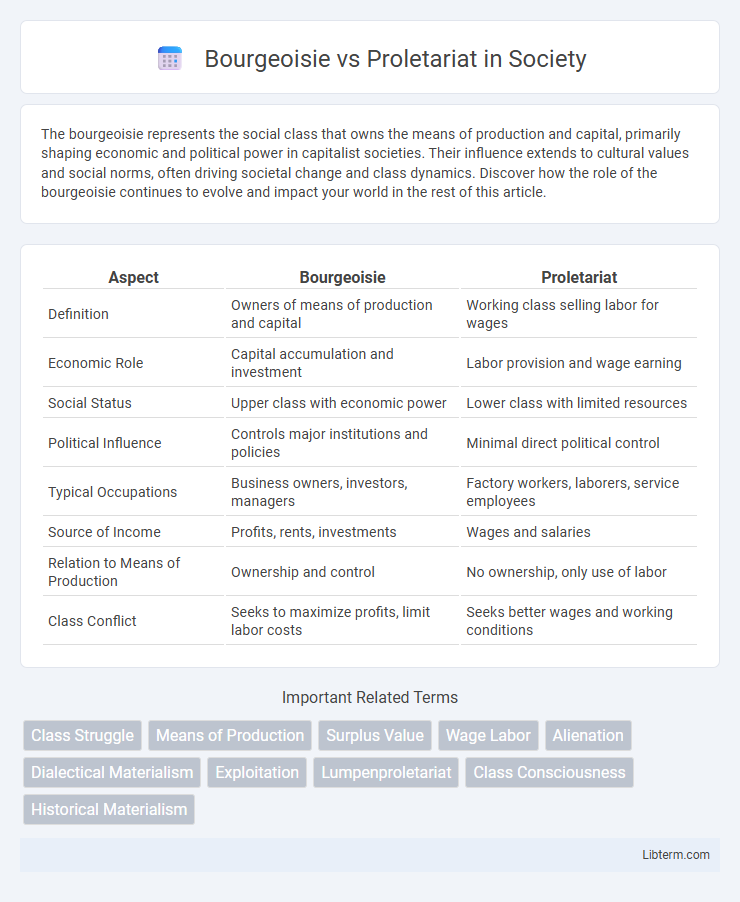The bourgeoisie represents the social class that owns the means of production and capital, primarily shaping economic and political power in capitalist societies. Their influence extends to cultural values and social norms, often driving societal change and class dynamics. Discover how the role of the bourgeoisie continues to evolve and impact your world in the rest of this article.
Table of Comparison
| Aspect | Bourgeoisie | Proletariat |
|---|---|---|
| Definition | Owners of means of production and capital | Working class selling labor for wages |
| Economic Role | Capital accumulation and investment | Labor provision and wage earning |
| Social Status | Upper class with economic power | Lower class with limited resources |
| Political Influence | Controls major institutions and policies | Minimal direct political control |
| Typical Occupations | Business owners, investors, managers | Factory workers, laborers, service employees |
| Source of Income | Profits, rents, investments | Wages and salaries |
| Relation to Means of Production | Ownership and control | No ownership, only use of labor |
| Class Conflict | Seeks to maximize profits, limit labor costs | Seeks better wages and working conditions |
Introduction to Bourgeoisie and Proletariat
Bourgeoisie refers to the capitalist class who own the means of production and control economic resources in a capitalist society. Proletariat consists of the working class who sell their labor to the bourgeoisie in exchange for wages but lack ownership of production. The fundamental conflict between bourgeoisie and proletariat underpins Marxist theory on class struggle and socioeconomic inequality.
Historical Origins of Class Division
The historical origins of class division between the Bourgeoisie and Proletariat trace back to the rise of capitalism during the Industrial Revolution in the 18th and 19th centuries. The Bourgeoisie emerged as the owning class controlling the means of production, while the Proletariat comprised wage laborers who sold their labor for survival. This division intensified socio-economic inequalities and shaped the dynamics of class struggle in modern industrial societies.
Defining the Bourgeoisie: Wealth and Power
The bourgeoisie represents the capitalist class owning the means of production, controlling vast wealth and economic resources that shape societal structures. Their accumulation of capital enables dominance over labor markets and political influence, consolidating power within industrial and financial sectors. This concentration of wealth distinguishes the bourgeoisie from the proletariat, who rely on wage labor without ownership stakes.
The Proletariat: Labor and Exploitation
The proletariat constitutes the working class engaged in labor production, often subjected to exploitation under capitalist systems where their labor generates surplus value appropriated by the bourgeoisie. This exploitation manifests through wage labor, where workers receive compensation below the true value of their produced goods and services, perpetuating economic inequality. The proletariat's struggle involves advocating for workers' rights, fair wages, and improved labor conditions to challenge systemic exploitation and achieve socio-economic justice.
Marxist Theory: Class Struggle Explained
Marxist theory defines the bourgeoisie as the capitalist class owning the means of production, while the proletariat comprises the working class selling labor. The inherent class struggle arises from the exploitation of proletariat labor, generating surplus value appropriated by the bourgeoisie. This conflict drives historical change and revolution, aiming to overthrow capitalist structures and establish a classless society.
Economic Inequality and Societal Impact
The conflict between the bourgeoisie, who control capital and production means, and the proletariat, the working class selling labor, underscores economic inequality through wealth concentration and wage disparity. This imbalance fosters systemic social stratification, limiting upward mobility and perpetuating poverty cycles within the proletariat. Economic inequality driven by bourgeois dominance triggers social unrest, class antagonism, and challenges to political stability in capitalist societies.
Bourgeoisie Control of Production
The bourgeoisie owns and controls the means of production, including factories, land, and capital, enabling them to dictate labor conditions and extract surplus value from workers' efforts. Their ownership establishes economic power that influences political policies and societal structures, ensuring continued dominance over resources and wealth distribution. This control perpetuates class divisions by maintaining systemic inequalities between the bourgeoisie and the proletariat.
Proletariat Movements and Revolutions
Proletariat movements and revolutions have historically aimed to dismantle bourgeoisie dominance by advocating for workers' rights, equitable wealth distribution, and the abolition of class exploitation. Key events such as the Russian Revolution of 1917 and the 1848 European uprisings exemplify the proletariat's organized efforts to seize political power from the bourgeoisie and establish socialist or communist states. Contemporary proletariat movements often emphasize labor union activism, social justice campaigns, and policies promoting economic equality to challenge capitalist structures upheld by the bourgeoisie.
Contemporary Relevance of Class Conflict
The contemporary relevance of bourgeoisie vs proletariat conflict persists as economic inequality intensifies in globalized capitalism, where the capitalist class controls disproportionate wealth and production means while the working class faces wage stagnation and job insecurity. Rising social movements and labor unions spotlight systemic class struggles, advocating for worker rights, fair wages, and redistribution policies to challenge entrenched power dynamics. Data from the OECD reveals widening income gaps, emphasizing the enduring tension between capital owners and laborers in shaping economic and social policies worldwide.
Conclusion: Toward Class Reconciliation
Class reconciliation between the bourgeoisie and proletariat requires addressing systemic inequalities through equitable economic policies and labor rights protections. Sustainable social harmony depends on fostering dialogue, redistributive justice, and collaborative frameworks that balance capital ownership with workers' welfare. Bridging class divides necessitates structural reforms that empower the proletariat while ensuring responsible bourgeoisie participation in socio-economic development.
Bourgeoisie Infographic

 libterm.com
libterm.com